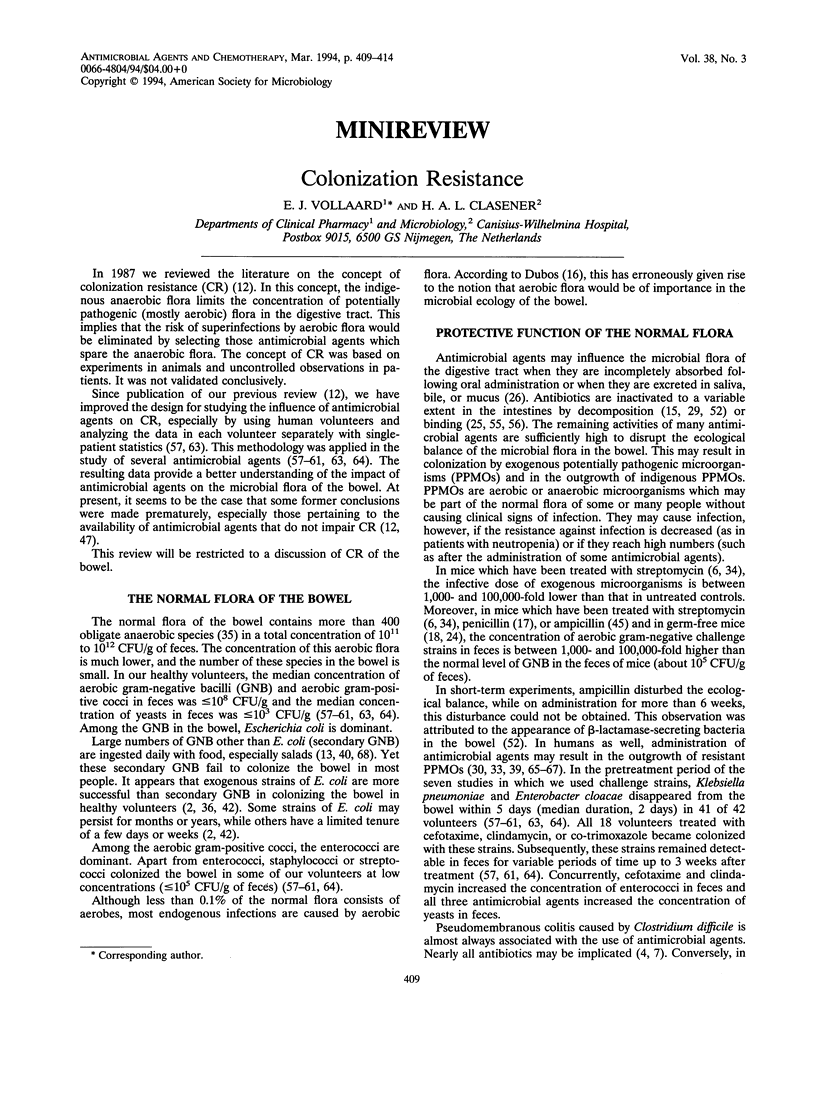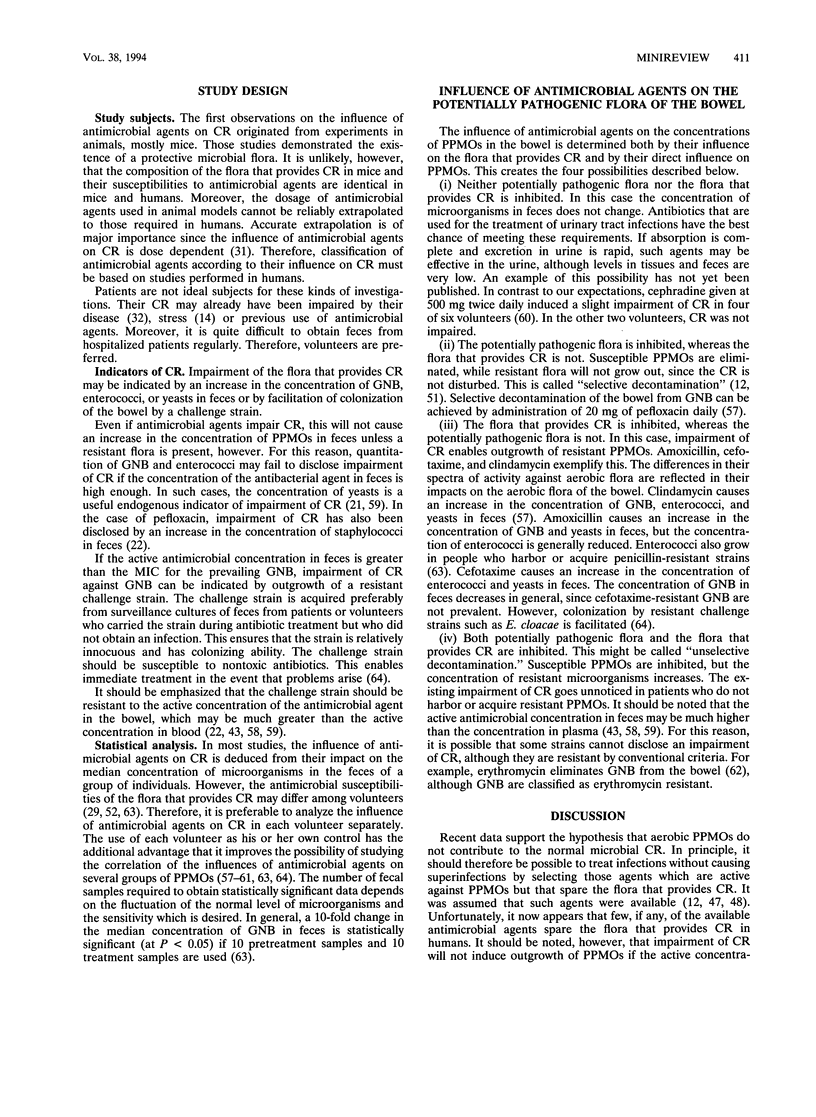Full text
PDF





Selected References
These references are in PubMed. This may not be the complete list of references from this article.
- Ahmad F., Bray G., Prescott R. W., Aquilla S., Lightfoot N. F. Use of ciprofloxacin to control a Salmonella outbreak in a long-stay psychiatric hospital. J Hosp Infect. 1991 Mar;17(3):171–178. doi: 10.1016/0195-6701(91)90228-z. [DOI] [PubMed] [Google Scholar]
- Apperloo-Renkema H. Z., van der Waaij D. Study of colonization resistance for Enterobacteriaceae in man by experimental contamination and biotyping as well as the possible role of antibodies in the clearance of these bacteria from the intestines. Epidemiol Infect. 1991 Dec;107(3):619–626. doi: 10.1017/s0950268800049311. [DOI] [PMC free article] [PubMed] [Google Scholar]
- BOHNHOFF M., DRAKE B. L., MILLER C. P. Effect of streptomycin on susceptibility of intestinal tract to experimental Salmonella infection. Proc Soc Exp Biol Med. 1954 May;86(1):132–137. doi: 10.3181/00379727-86-21030. [DOI] [PubMed] [Google Scholar]
- Barnham M. The gut as a source of the haemolytic streptococci causing infection in surgery of the intestinal and biliary tracts. J Infect. 1983 Mar;6(2):129–139. doi: 10.1016/s0163-4453(83)92694-4. [DOI] [PubMed] [Google Scholar]
- Barza M., Giuliano M., Jacobus N. V., Gorbach S. L. Effect of broad-spectrum parenteral antibiotics on "colonization resistance" of intestinal microflora of humans. Antimicrob Agents Chemother. 1987 May;31(5):723–727. doi: 10.1128/aac.31.5.723. [DOI] [PMC free article] [PubMed] [Google Scholar]
- Borriello S. P. 12th C. L. Oakley lecture. Pathogenesis of Clostridium difficile infection of the gut. J Med Microbiol. 1990 Dec;33(4):207–215. doi: 10.1099/00222615-33-4-207. [DOI] [PubMed] [Google Scholar]
- Bowden T. A., Jr, Mansberger A. R., Jr, Lykins L. E. Pseudomembraneous enterocolitis: mechanism for restoring floral homeostasis. Am Surg. 1981 Apr;47(4):178–183. [PubMed] [Google Scholar]
- Brun-Buisson C., Legrand P., Rauss A., Richard C., Montravers F., Besbes M., Meakins J. L., Soussy C. J., Lemaire F. Intestinal decontamination for control of nosocomial multiresistant gram-negative bacilli. Study of an outbreak in an intensive care unit. Ann Intern Med. 1989 Jun 1;110(11):873–881. doi: 10.7326/0003-4819-110-11-873. [DOI] [PubMed] [Google Scholar]
- Christensen G. D., Korones S. B., Reed L., Bulley R., McLaughlin B., Bisno A. L. Epidemic Serratia marcescens in a neonatal intensive care unit: importance of the gastrointestinal tract as a reservoir. Infect Control. 1982 Mar-Apr;3(2):127–133. doi: 10.1017/s0195941700055909. [DOI] [PubMed] [Google Scholar]
- Clasener H. A., Vollaard E. J., van Saene H. K. Long-term prophylaxis of infection by selective decontamination in leukopenia and in mechanical ventilation. Rev Infect Dis. 1987 Mar-Apr;9(2):295–328. doi: 10.1093/clinids/9.2.295. [DOI] [PubMed] [Google Scholar]
- Corpet D. E. Antibiotic resistance from food. N Engl J Med. 1988 May 5;318(18):1206–1207. doi: 10.1056/nejm198805053181818. [DOI] [PMC free article] [PubMed] [Google Scholar]
- Dal Nogare A. R., Toews G. B., Pierce A. K. Increased salivary elastase precedes gram-negative bacillary colonization in postoperative patients. Am Rev Respir Dis. 1987 Mar;135(3):671–675. doi: 10.1164/arrd.1987.135.3.671. [DOI] [PubMed] [Google Scholar]
- Ducluzeau R., Ladire M., Callut C., Raibaud P., Abrams G. D. Antagonistic effect of extremely oxygen-sensitive clostridia from the microflora of conventional mice and of Escherichia coli against Shigella flexneri in the digestive tract of gnotobiotic mice. Infect Immun. 1977 Aug;17(2):415–424. doi: 10.1128/iai.17.2.415-424.1977. [DOI] [PMC free article] [PubMed] [Google Scholar]
- Flynn D. M., Weinstein R. A., Nathan C., Gaston M. A., Kabins S. A. Patients' endogenous flora as the source of "nosocomial" Enterobacter in cardiac surgery. J Infect Dis. 1987 Aug;156(2):363–368. doi: 10.1093/infdis/156.2.363. [DOI] [PubMed] [Google Scholar]
- Freter R., Abrams G. D. Function of various intestinal bacteria in converting germfree mice to the normal state. Infect Immun. 1972 Aug;6(2):119–126. doi: 10.1128/iai.6.2.119-126.1972. [DOI] [PMC free article] [PubMed] [Google Scholar]
- Giuliano M., Barza M., Jacobus N. V., Gorbach S. L. Effect of broad-spectrum parenteral antibiotics on composition of intestinal microflora of humans. Antimicrob Agents Chemother. 1987 Feb;31(2):202–206. doi: 10.1128/aac.31.2.202. [DOI] [PMC free article] [PubMed] [Google Scholar]
- Giuliano M., Pantosti A., Gentile G., Venditti M., Arcese W., Martino P. Effects on oral and intestinal microfloras of norfloxacin and pefloxacin for selective decontamination in bone marrow transplant patients. Antimicrob Agents Chemother. 1989 Oct;33(10):1709–1713. doi: 10.1128/aac.33.10.1709. [DOI] [PMC free article] [PubMed] [Google Scholar]
- Haralambie E., Mahmoud H. K., Linzenmeier G., Wendt F. The "clostridial effect" of selective decontamination of the human gut with trimethoprim/sulphamethoxazole in neutropenic patients. Infection. 1983 Jul-Aug;11(4):201–204. doi: 10.1007/BF01641197. [DOI] [PubMed] [Google Scholar]
- Hazenberg M. P., Bakker M., Verschoor-Burggraaf A. Effects of the human intestinal flora on germ-free mice. J Appl Bacteriol. 1981 Feb;50(1):95–106. doi: 10.1111/j.1365-2672.1981.tb00874.x. [DOI] [PubMed] [Google Scholar]
- Hazenberg M. P., Pennock-Schröder A. M., Van den Boom M., Van de Merwe J. P. Binding to and antibacterial effect of ampicillin, neomycin and polymyxin B on human faeces. J Hyg (Lond) 1984 Aug;93(1):27–34. doi: 10.1017/s0022172400060897. [DOI] [PMC free article] [PubMed] [Google Scholar]
- Heimdahl A., Kager L., Nord C. E. Changes in the oropharyngeal and colon microflora in relation to antimicrobial concentrations in saliva and faeces. Scand J Infect Dis Suppl. 1985;44:52–58. [PubMed] [Google Scholar]
- Hughes W. T., Kuhn S., Chaudhary S., Feldman S., Verzosa M., Aur R. J., Pratt C., George S. L. Successful chemoprophylaxis for Pneumocystis carinii pneumonitis. N Engl J Med. 1977 Dec 29;297(26):1419–1426. doi: 10.1056/NEJM197712292972602. [DOI] [PubMed] [Google Scholar]
- Jackson R. J., Smith S. D., Rowe M. I. Selective bowel decontamination results in gram-positive translocation. J Surg Res. 1990 May;48(5):444–447. doi: 10.1016/0022-4804(90)90010-y. [DOI] [PubMed] [Google Scholar]
- LOURIA D. B., BRAYTON R. G. THE EFFICACY OF PENICILLIN REGIMENS, WITH OBSERVATIONS ON THE FREQUENCY OF SUPERINFECTION. JAMA. 1963 Dec 14;186:987–990. [PubMed] [Google Scholar]
- Levy S. B. Playing antibiotic pool: to tally the score. N Engl J Med. 1984 Sep 6;311(10):663–665. doi: 10.1056/NEJM198409063111009. [DOI] [PubMed] [Google Scholar]
- Léonard F., Andremont A., Leclerq B., Labia R., Tancrède C. Use of beta-lactamase-producing anaerobes to prevent ceftriaxone from degrading intestinal resistance to colonization. J Infect Dis. 1989 Aug;160(2):274–280. doi: 10.1093/infdis/160.2.274. [DOI] [PubMed] [Google Scholar]
- Mackowiak P. A., Martin R. M., Smith J. W. The role of bacterial interference in the increased prevalence of oropharyngeal gram-negative bacilli among alcoholics and diabetics. Am Rev Respir Dis. 1979 Sep;120(3):589–593. doi: 10.1164/arrd.1979.120.3.589. [DOI] [PubMed] [Google Scholar]
- McCOY E. Changes in the host flora induced by chemotherapeutic agents. Annu Rev Microbiol. 1954;8:257–272. doi: 10.1146/annurev.mi.08.100154.001353. [DOI] [PubMed] [Google Scholar]
- Moore W. E., Holdeman L. V. Human fecal flora: the normal flora of 20 Japanese-Hawaiians. Appl Microbiol. 1974 May;27(5):961–979. doi: 10.1128/am.27.5.961-979.1974. [DOI] [PMC free article] [PubMed] [Google Scholar]
- Murray B. E., Mathewson J. J., DuPont H. L., Ericsson C. D., Reves R. R. Emergence of resistant fecal Escherichia coli in travelers not taking prophylactic antimicrobial agents. Antimicrob Agents Chemother. 1990 Apr;34(4):515–518. doi: 10.1128/aac.34.4.515. [DOI] [PMC free article] [PubMed] [Google Scholar]
- Olson B., Weinstein R. A., Nathan C., Chamberlin W., Kabins S. A. Epidemiology of endemic Pseudomonas aeruginosa: why infection control efforts have failed. J Infect Dis. 1984 Dec;150(6):808–816. doi: 10.1093/infdis/150.6.808. [DOI] [PubMed] [Google Scholar]
- Price D. J., Sleigh J. D. Control of infection due to Klebsiella aerogenes in a neurosurgical unit by withdrawal of all antibiotics. Lancet. 1970 Dec 12;2(7685):1213–1215. doi: 10.1016/s0140-6736(70)92179-3. [DOI] [PubMed] [Google Scholar]
- SEARS H. J., BROWNLEE I., UCHIYAMA J. K. Persistence of individual strains of Escherichia coli in the intestinal tract of man. J Bacteriol. 1950 Feb;59(2):293–301. doi: 10.1128/jb.59.2.293-301.1950. [DOI] [PMC free article] [PubMed] [Google Scholar]
- Schwan A., Sjölin S., Trottestam U., Aronsson B. Relapsing clostridium difficile enterocolitis cured by rectal infusion of homologous faeces. Lancet. 1983 Oct 8;2(8354):845–845. doi: 10.1016/s0140-6736(83)90753-5. [DOI] [PubMed] [Google Scholar]
- Taylor M. E., Oppenheim B. A. Selective decontamination of the gastrointestinal tract as an infection control measure. J Hosp Infect. 1991 Apr;17(4):271–278. doi: 10.1016/0195-6701(91)90271-9. [DOI] [PubMed] [Google Scholar]
- Thijm H. A., van der Waaij D. The effect of three frequently applied antibiotics on the colonization resistance of the digestive tract of mice. J Hyg (Lond) 1979 Jun;82(3):397–405. doi: 10.1017/s0022172400053924. [DOI] [PMC free article] [PubMed] [Google Scholar]
- Tvede M., Rask-Madsen J. Bacteriotherapy for chronic relapsing Clostridium difficile diarrhoea in six patients. Lancet. 1989 May 27;1(8648):1156–1160. doi: 10.1016/s0140-6736(89)92749-9. [DOI] [PubMed] [Google Scholar]
- Veringa E. M., van der Waaij D. Biological inactivation by faeces of antimicrobial drugs applicable in selective decontamination of the digestive tract. J Antimicrob Chemother. 1984 Dec;14(6):605–612. doi: 10.1093/jac/14.6.605. [DOI] [PubMed] [Google Scholar]
- Vollaard E. J., Clasener H. A., Janssen A. J. Co-trimoxazole impairs colonization resistance in healthy volunteers. J Antimicrob Chemother. 1992 Nov;30(5):685–691. doi: 10.1093/jac/30.5.685. [DOI] [PubMed] [Google Scholar]
- Vollaard E. J., Clasener H. A., Janssen A. J. Decontamination of the bowel by intravenous administration of pefloxacin. J Antimicrob Chemother. 1990 Dec;26(6):847–852. doi: 10.1093/jac/26.6.847. [DOI] [PubMed] [Google Scholar]
- Vollaard E. J., Clasener H. A., Janssen A. J. Influence of pefloxacin on microbial colonization resistance in healthy volunteers. Eur J Clin Microbiol Infect Dis. 1992 Mar;11(3):257–260. doi: 10.1007/BF02098093. [DOI] [PubMed] [Google Scholar]
- Vollaard E. J., Clasener H. A., Janssen A. J. The contribution of Escherichia coli to microbial colonization resistance. J Antimicrob Chemother. 1990 Sep;26(3):411–418. doi: 10.1093/jac/26.3.411. [DOI] [PubMed] [Google Scholar]
- Vollaard E. J., Clasener H. A., Janssen A. J., Wynne H. J. Influence of amoxycillin on microbial colonization resistance in healthy volunteers. A methodological study. J Antimicrob Chemother. 1990 May;25(5):861–871. doi: 10.1093/jac/25.5.861. [DOI] [PubMed] [Google Scholar]
- Vollaard E. J., Clasener H. A., Janssen A. J., Wynne H. J. Influence of cefotaxime on microbial colonization resistance in healthy volunteers. J Antimicrob Chemother. 1990 Jul;26(1):117–123. doi: 10.1093/jac/26.1.117. [DOI] [PubMed] [Google Scholar]
- WEINSTEIN L., GOLDFIELD M., CHANG TE-WEN Infections occurring during chemotherapy; a study of their frequency, type and predisposing factors. N Engl J Med. 1954 Aug 12;251(7):247–255. doi: 10.1056/NEJM195408122510701. [DOI] [PubMed] [Google Scholar]
- Weinstein L., Brown R. B. Colonization, suprainfection and superinfection: major microbiologic and clinical problems. Mt Sinai J Med. 1977 Jan-Feb;44(1):100–112. [PubMed] [Google Scholar]
- Wright C., Kominos S. D., Yee R. B. Enterobacteriaceae and Pseudomonas aeruginosa recovered from vegetable salads. Appl Environ Microbiol. 1976 Mar;31(3):453–454. doi: 10.1128/aem.31.3.453-454.1976. [DOI] [PMC free article] [PubMed] [Google Scholar]
- de Vries-Hospers H. G., Welling G. W., Swabb E. A., van der Waaij D. Selective decontamination of the digestive tract with aztreonam: a study of 10 healthy volunteers. J Infect Dis. 1984 Nov;150(5):636–642. doi: 10.1093/infdis/150.5.636. [DOI] [PubMed] [Google Scholar]
- van Saene H. K., Stoutenbeek C. C., Stoller J. K. Selective decontamination of the digestive tract in the intensive care unit: current status and future prospects. Crit Care Med. 1992 May;20(5):691–703. doi: 10.1097/00003246-199205000-00024. [DOI] [PubMed] [Google Scholar]
- van Saene J. J., van Saene H. K., Stoutenbeek C. P., Lerk C. F. Influence of faeces on the activity of antimicrobial agents used for decontamination of the alimentary canal. Scand J Infect Dis. 1985;17(3):295–300. [PubMed] [Google Scholar]
- van der Waaij D., Berghuis-de Vries J. M., Lekkerkerk Lekkerkerk-v Colonization resistance of the digestive tract in conventional and antibiotic-treated mice. J Hyg (Lond) 1971 Sep;69(3):405–411. doi: 10.1017/s0022172400021653. [DOI] [PMC free article] [PubMed] [Google Scholar]
- van der Waaij D., Vossen J. M., Altes C. K., Hartgrink C. Reconventionalization following antibiotic decontamination in man and animals. Am J Clin Nutr. 1977 Nov;30(11):1887–1895. doi: 10.1093/ajcn/30.11.1887. [DOI] [PubMed] [Google Scholar]
- van der Waaij D., de Vries-Hospers H. G., Welling G. W. The influence of antibiotics on gut colonization. J Antimicrob Chemother. 1986 Oct;18 (Suppl 100):155–158. doi: 10.1093/jac/18.supplement_c.155. [DOI] [PubMed] [Google Scholar]


